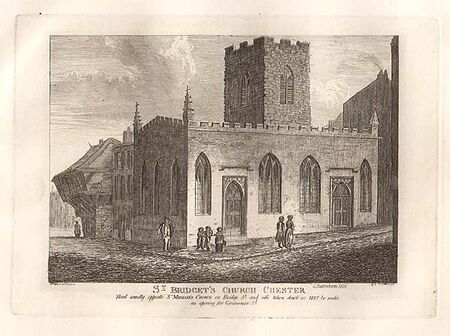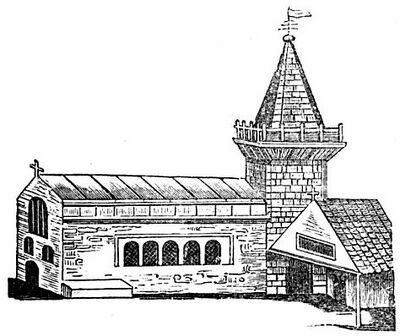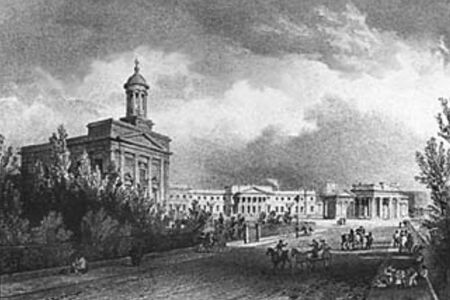St Bridget

An ancient parish church, serving part of the city of Chester. The original church stood at the angle of Whitefriars and Bridge Street until 1829 when it was removed during the construction of the Grosvenor Bridge and Grosvenor Street. A replacement church was built to the west of the new Castle Esplanade.

Foundation
Hemingway writes:
- "The origin of St Bridget's church is buried in obscurity but it may probably be dated from the reign of King Offa who died ad 797 about which time we read That 'divers parish churches were erected in Chester'"
Brigid is a pre-christian goddess associated with the spring season, fertility, healing, poetry and blacksmithing. In the early Middle Ages the goddess Brigid was syncretized with the Christian saint of the same name, who apparently lived in the 5th/6th century. Unsurprisingly therefore, the saint's feast day (1st Feb) co-incided with "Imbolc", a Gaelic traditional festival marking the beginning of spring. She was removed from the official catholic calendar in 1969.
St. Brigid is associated with perpetual, sacred flames, such as the one maintained by 19 nuns at her sanctuary in Kildare. The tradition of female priestesses tending sacred, eternal flames is a feature of ancient Indo-European pre-Christian spirituality. Other examples include the Roman goddess Vesta, and other hearth-goddesses, such as the Greek Hestia. The site of the church is close to that of the Porta Praetoria (main gate) of Roman Chester and it is likely that the church was either first built as a re-use of the Roman structure or of its stonework. Possibly St Michael originated in the same way.
Early History
There was a rapid turnover of incumbents in the early 17th century, suggesting an especially undesirable living. Matters improved with the appointment of the composer Francis Pilkington (rector 1616–38), who although also precentor of the cathedral and minister at St. Martin's continued to treat St. Bridget's as his principal cure, securing benefactions from the mayor, Sir Thomas Smith
A single-celled, probably late-medieval building survived until c. 1690, when it was totally reconstructed in local stone with funds raised largely by briefs granted in 1684–5 and 1694. The new church was repaired in 1727 and again in 1785, when it was refaced in stone under the direction of Joseph, Turner. By 1825, however, the whole structure was unsafe.
Hemingway adds:
- "About the middle of the seventeenth century the church was taken down previous to which its appearance is represented by the wood engraving copied from a sketch made by Randal Holmes. On the removal of this structure the church was rebuilt when a wall was erected round it which enclosed several feet of the streets on the east and north sides then used as a burying ground. In the year 1745 ground was purchased by the parish behind the church, the interred bodies were removed, and all the ground on the north and east of the church thrown to the street, much to the public inconvenience".
The Second Church

When Grosvenor Street was cut diagonally across the City in 1825 to form the approach Harrison's new Grosvenor Bridge, St. Bridget was demolished and William Cole (Harrison's pupil) designed a new church bearing the same dedication, which was erected close to Harrison's recently-rebuilt Chester Castle. It was restored in 1861 under the direction of James Harrison. Thomas Harrison had been buried in the churchyard, and in the 1960s, to make way for a traffic island on the new Inner Ring Road, Harrisons remains were transferred to Blacon Cemetery.
Disappearance
On 27 April 1842 the district was united with that of Chester: St Martin to form the combined district of "St. Bridget with St. Martin".
The district was affected by the following boundary changes:
- 1882 February 17 — reduced when part of the ancient parish of St Martin was transferred to Chester: St Peter.
- 1887 September 27 — reduced when the following part of the ancient parish of St. Martin was transferred to Chester: Holy Trinity: "All that wedge shaped detached portion of the said parish of Saint Martin bounded on the north partly by the ancient parish of Saint Oswald in the said city of Chester and partly by a portion of the same ancient parish which has for ecclesiastical purposes been annexed to the parish of Saint Peter in the same city on the east by the portion of the said parish of Saint Martin annexed to the parish of Saint Peter aforesaid and on the south and westerly sides thereof by the said parish of Holy Trinity aforesaid"
- 1887 September 27 — extended when the following area was transferred from Chester: St. Mary without the Walls: "All that portion of the said parish of Saint Mary-on-the-Hill which is bounded on the south by the River Dee on the east by the centre of Lower Bridge-street in the city of Chester from the south boundary of the said parish to a point where Duke-street in the same city debouches into Lower Bridge-street aforesaid, and thence partly by the said parish of St Olave partly by the said parish of St Michael and partly by a detached portion of the parish of Saint Bridget on the north partly by the said parish of Saint Michael partly by the said parish of Saint Bridget and partly by the said parish of Saint Martin and on the east by the said parish of Holy Trinity. And also all that detached portion of the said parish of Saint Mary-on-the-Hill abutting upon Lower Bridge-street aforesaid at the northerly end thereof bounded on the south- east and north sides thereof by the said parish of Saint Michael and on the west side by a detached portion of the said parish of Saint Bridget"
- 1887 September 27 — reduced when the following area was transferred to Chester: St. Mary without the Walls: "Part of the said parish of Saint Bridget situate on the south side of the said river in the city of Chester... bounded on the north and east sides thereof by the parish of Saint John the Baptist in the city of Chester along the course of the said River Dee and on the south and west sides thereof by the said parish of Saint Mary-on-the-Hill."
In 1891 St. Bridget's church was pulled down, and the church of Chester: St Mary on the Hill was constituted the district church for the district of St. Bridget with St. Martin. In January 1973 this became part of a unified district for the city of Chester. All that remains today are a few graves marking the site of the Churchyard, including that of Thomas Gould, who is buried under the roundabout between Grosvenor Street and Grosvenor Road. This is the site of the graveyard of St Bridget (since demolished). The grave marker is shaped as a casket and inscribed:
- IN MEMORY OF THOMAS GOULD LATE OF THE 52ND REGT. OF FOOT LI. DIED IN NOVEMBER 1865 AGED 72 YEARS 46 OF WHICH WERE SPENT IN THE SERVICE OF HIS COUNTRY. HE WAS PRESENT IN THE FOLLOWING ENGAGEMENTS. VIMERA, CORUNA, CROSSING THE GOE NEAR ALMEIDA, BSACO, PUMBAL, REDINHA, CONDEIXA, FOZ D'AVOCA, SARUGAL, FUENTES DONOLE, STORMING OF CUIDAD RODRIGO AND RADASOS SALMANCA, SAN MUNOS (fallen prisoner), ST MILAN, VITTORIA, PYRENEES, STORMING OF THE FRENCH ESTABLISHMENT OF VERA (wounded), NIVELLE, PASSAGE OF THE NEVE ORTHES, TARBES, TOULOUSE AND WATERLOO. HE RECEIVED THE PENINSULA MEDAL WITH 13 CLASPS AND THE WATERLOO MEDAL. THE STONE IS PLACED OVER HIM BY A FEW FRIENDS
sources
- Genuki;
- Tom Goulds Grave at English Heritage;
- Thomas Gould and St Bridget's on Chester Walls Info;
- Further information on the Church from British History Online;
- Barnes, G. K., (2001). V: New Bridge, new road, new church: the building of Grosvenor Street in Chester. Journal of the Chester Archaeological Society 76. Vol 76, pp. 127-151.

